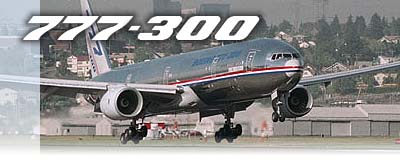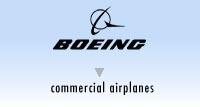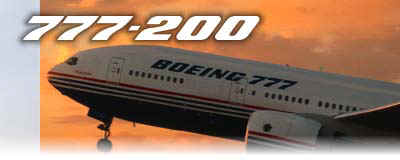 
|
||||||
|
|
|
|
||||
|
|
||||||
|
Boeing 777-300 Background
|
|
The Boeing 777-300 is a high-capacity stretched version of the newest wide-body twinjet from Boeing Commercial Airplane Group. This newest member of the 777 family of jetliners is "market driven" to meet airline demand for a jetliner sized to replace older wide-body airplanes, including early versions of the 747. The 777-300 complements the 777-200 models by providing greater capacity and lower costs per seat within the 777 family. Specifications In terms of range capability, the 777-300 can serve routes up to 5,960 nautical miles (11,030 km). A typical route is Tokyo to Singapore, Honolulu to Seoul or San Francisco to Tokyo. The 777-300 has nearly the same passenger capacity and range capability as the 747-100/-200 models, but burns one-third less fuel and has 40 percent lower maintenance costs. The overall result for airlines is cash operating costs one-third below early model 747s. Baseline maximum takeoff weight is 580,000 pounds (263,085 kg); highest maximum takeoff weight being offered is 660,000 pounds (299,375 kg). Maximum fuel capacity is 45,220 gallons (171,155 L). The 777-300 can accommodate eight 96- by 125-inch (2.44- by 3.17-m) pallets, 20 LD-3 containers and 600 cubic feet (17 m3) of bulk cargo in its lower holds, for a total available cargo volume of 7,080 cubic feet (200.5 m3). Background The formal authorization, or "go-ahead," for the program followed announcements at the 1995 Paris Air Show that four airlines (All Nippon Airways, Cathay Pacific Airways, Korean Airlines and Thai Airways International) intended to order 31 of the long-range twinjets valued at approximately $3.1 billion, depending on configurations, special features and options selected -- the first Boeing program launched entirely with international orders. With delivery of the first 777-300 in May 1998 to Cathay Pacific Airways of Hong Kong, the 777 family of aircraft provides the unparalleled level of flexibility, economy and capability originally envisioned with the launch of the program in 1990. The 777-300 offers all the new features of passenger comfort found in the 777-200 -- including cabin spaciousness and flexibility. Engine options are the Pratt & Whitney PW4090 and PW4098 and the Rolls Royce Trent 892. |
